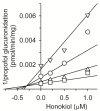Effect of honokiol on cytochrome P450 and UDP-glucuronosyltransferase enzyme activities in human liver microsomes
- PMID: 24005963
- PMCID: PMC6269737
- DOI: 10.3390/molecules180910681
Effect of honokiol on cytochrome P450 and UDP-glucuronosyltransferase enzyme activities in human liver microsomes
Abstract
Honokiol is a bioactive component isolated from the medicinal herbs Magnolia officinalis and Magnolia grandiflora that has antioxidative, anti-inflammatory, antithrombotic, and antitumor activities. The inhibitory potentials of honokiol on eight major human cytochrome P450 (CYP) enzymes 1A2, 2A6, 2B6, 2C8, 2C9, 2C19, 2D6, and 3A4, and four UDP-glucuronosyltransferases (UGTs) 1A1, 1A4, 1A9, and 2B7 in human liver microsomes were investigated using liquid chromatography-tandem mass spectrometry. Honokiol strongly inhibited CYP1A2-mediated phenacetin O-deethylation, CYP2C8-mediated amodiaquine N-deethylation, CYP2C9-mediated diclofenac 4-hydroxylation, CYP2C19-mediated [S]-mephenytoin 4-hydroxylation, and UGT1A9-mediated propofol glucuronidation with K(i) values of 1.2, 4.9, 0.54, 0.57, and 0.3 μM, respectively. Honokiol also moderately inhibited CYP2B6-mediated bupropion hydroxylation and CYP2D6-mediated bufuralol 1'-hydroxylation with K(i) values of 17.5 and 12.0 μM, respectively. These in vitro results indicate that honokiol has the potential to cause pharmacokinetic drug interactions with other co-administered drugs metabolized by CYP1A2, CYP2C8, CYP2C9, CYP2C19, and UGT1A9.
Figures



Similar articles
-
Inhibitory Effects of Aschantin on Cytochrome P450 and Uridine 5'-diphospho-glucuronosyltransferase Enzyme Activities in Human Liver Microsomes.Molecules. 2016 Apr 27;21(5):554. doi: 10.3390/molecules21050554. Molecules. 2016. PMID: 27128896 Free PMC article.
-
AM-2201 Inhibits Multiple Cytochrome P450 and Uridine 5'-Diphospho-Glucuronosyltransferase Enzyme Activities in Human Liver Microsomes.Molecules. 2017 Mar 10;22(3):443. doi: 10.3390/molecules22030443. Molecules. 2017. PMID: 28287454 Free PMC article.
-
Inhibition of cytochrome P450 and uridine 5'-diphospho-glucuronosyltransferases by MAM-2201 in human liver microsomes.Arch Pharm Res. 2017 Jun;40(6):727-735. doi: 10.1007/s12272-017-0917-y. Epub 2017 May 8. Arch Pharm Res. 2017. PMID: 28484907
-
Renal drug metabolism in humans: the potential for drug-endobiotic interactions involving cytochrome P450 (CYP) and UDP-glucuronosyltransferase (UGT).Br J Clin Pharmacol. 2013 Oct;76(4):587-602. doi: 10.1111/bcp.12086. Br J Clin Pharmacol. 2013. PMID: 23362865 Free PMC article. Review.
-
[Research progress on in vitro effects of traditional Chinese medicine ingredients on liver UDP-glucuronosyltransferases].Zhongguo Zhong Yao Za Zhi. 2024 Oct;49(20):5397-5409. doi: 10.19540/j.cnki.cjcmm.20240709.201. Zhongguo Zhong Yao Za Zhi. 2024. PMID: 39701723 Review. Chinese.
Cited by
-
Recent progress and challenges in screening and characterization of UGT1A1 inhibitors.Acta Pharm Sin B. 2019 Mar;9(2):258-278. doi: 10.1016/j.apsb.2018.09.005. Epub 2018 Sep 14. Acta Pharm Sin B. 2019. PMID: 30972276 Free PMC article. Review.
-
Honokiol attenuates acetaminophen-induced acute liver injury by inhibiting hepatic CYP1A2 activity and improving liver mitochondrial dysfunction.Chin Herb Med. 2023 Mar 29;15(2):231-239. doi: 10.1016/j.chmed.2023.01.002. eCollection 2023 Apr. Chin Herb Med. 2023. PMID: 37265773 Free PMC article.
-
Inhibitory Effects of Aschantin on Cytochrome P450 and Uridine 5'-diphospho-glucuronosyltransferase Enzyme Activities in Human Liver Microsomes.Molecules. 2016 Apr 27;21(5):554. doi: 10.3390/molecules21050554. Molecules. 2016. PMID: 27128896 Free PMC article.
-
Modulation of Rat Hepatic CYP1A and 2C Activity by Honokiol and Magnolol: Differential Effects on Phenacetin and Diclofenac Pharmacokinetics In Vivo.Molecules. 2018 Jun 17;23(6):1470. doi: 10.3390/molecules23061470. Molecules. 2018. PMID: 29914211 Free PMC article.
-
Inhibitory Effects of Triptolide on Human Liver Cytochrome P450 Enzymes and P-Glycoprotein.Eur J Drug Metab Pharmacokinet. 2017 Feb;42(1):89-98. doi: 10.1007/s13318-016-0323-8. Eur J Drug Metab Pharmacokinet. 2017. PMID: 26874845
References
-
- Kim B.H., Cho J.Y. Anti-inflammatory effect of honokiol is mediated by PI3K/Akt pathway suppression. Acta Pharmacol. Sin. 2008;29:113–122. - PubMed
-
- Lee J., Jung E., Park J., Jung K., Lee S., Hong S., Park E., Kim J., Park S., Park D. Anti-inflammatory effects of magnolol and honokiol are mediated through inhibition of the downstream pathway of MEKK-1 in NF-kappaB activation signaling. Planta Med. 2005;71:338–343. - PubMed
Publication types
MeSH terms
Substances
LinkOut - more resources
Full Text Sources
Other Literature Sources

